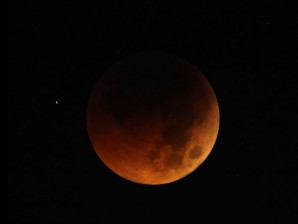Lunar eclipse turns moon blood red

WHAT HAPPENED TO BLUE MOON? A series of shots of the lunar eclipse, where the moon turns red at its peak, taken by the Inquirer chief photographer Ernie Sarmiento at dawn on Thursday over Cainta, Rizal.
SYDNEY—The longest lunar eclipse in more than a decade turned the moon blood red on Thursday, yielding a rare visual treat for stargazers across a large swathe of the planet from Asia to Europe.
The first eclipse of the year—when the Earth casts its shadow over the moon—was seen in parts of Europe, Africa, Asia and Australia.
The moon often turns brown in an eclipse, but this time it became a reddish, coppery color.
Contrary to some Internet chatter, the moon’s vivid red hue was not necessarily the result of ash from the erupting Puyehue volcano, high in Chile’s Andes, according to Sydney Observatory astronomer Geoffrey Wyatt.
Article continues after this advertisement“We can’t say for sure,” Wyatt said. “The red color is not caused by dust in the atmosphere. What dust does is extinguish color and make it look darker.”
Article continues after this advertisementThe terrestrial shadow started to fall at 1:24 a.m. in the Philippines on Thursday (1724 GMT Wednesday) and lifted around 7 a.m. (2300 GMT), although “totality”—when the lunar face is completely covered—lasted 100 minutes. That was the longest since July 2000.
Clear view in Manila

The moon exhibits a deep orange glow as the Earth casts its shadow in a total lunar eclipse as seen in Manila before dawn Thursday. Asian and African night owls were treated to a lunar eclipse, and ash in the atmosphere from a Chilean volcano turned it blood red for some viewers. AP
While keen astronomers in some parts of the world had to contend with dense cloud cover and rain, those in the Philippines had a clear view of the eclipse.
In Metro Manila, hundreds of amateur and professional astronomers converged before dawn to catch a glimpse of the celestial phenomenon.
With blankets and flasks of coffee, they were rewarded with clear skies.
“I will never get tired of watching these events,” said Maximo Sacro, 67, the retired curator of the National Museum Planetarium who dusted off his telephoto lens to capture the image.
“The moon’s entry into the Earth’s shadow was right smack in the middle, it was just perfect. It was very rare and the duration was long,” Sacro said.
In Australia, around 130 people watched at the Sydney Observatory, with one woman dressed as a vampire.
“There was (also) a child dressed very elegantly as if she was from another century, and a little boy dressed up as a red superhuman,” said Toner Stevenson, the observatory’s manager.
Best view
But Fred Watson, chief astronomer at the Australian Astronomical Observatory, said the best view would have been from the moon itself.
“If you could watch the phenomenon, you would see the Earth moving across the sun and it creating a brilliant red rim around the Earth,” he said.
In Singapore, more than 700 people gathered outside a science center to watch.
Some avid enthusiasts staked out spots more than four hours ahead of schedule with the center organizing astronomy talks and movie screenings to entertain the audience.
Moon carnival
The eclipse was widely seen across Pakistan and India, with crowds gathered at New Delhi’s Nehru planetarium, which organized a “moon carnival” and set up special viewing telescopes.
But traditionalists were not as enthusiastic, with authorities at several Indian temples reportedly shutting their doors to ward off the supposed “evil effects” of the eclipse.
In the Afghan capital Kabul, mosques were packed, as crowds recited verses from the Koran and offered special prayers.
“In Afghanistan, people believe that the eclipse is a sign of the power of Allah,” said Mir Ahmad Joyenda, an Afghan analyst who commentates on culture and society.
“People usually offer special prayers and shout Allah Akbar (God is great) at the time of the eclipse. Most of them are not aware how and why the eclipse takes place,” he added.
Google view
While the phenomenon was not seen everywhere, including the United States, space lovers still got a chance to see it unfold as Google teamed up with Slooh.com.
Slooh accesses telescopes around the world and Google live-streamed the event, with audio narration from astronomers. And on its home page, Google replaced its usual banner “doodle” with an animated eclipse.
The next total lunar eclipse will be on Dec. 10. There will be partial solar eclipses on July 1 and Nov. 25, but the next total solar eclipse will not take place until Nov. 13, 2012. AFP